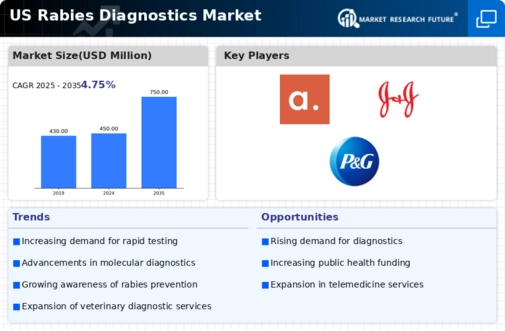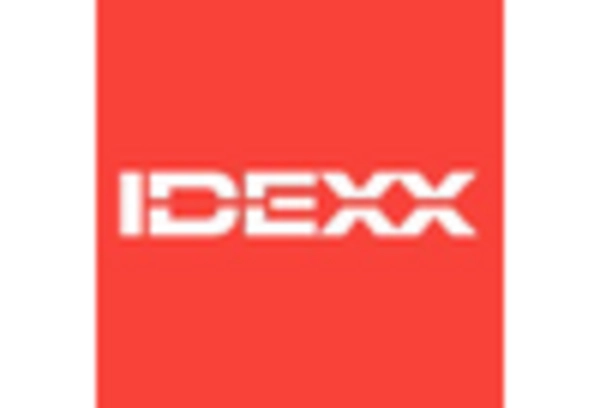Rising Incidence of Rabies Cases
The rabies diagnostics market is experiencing growth due to the rising incidence of rabies cases in the United States. According to the Centers for Disease Control and Prevention (CDC), rabies remains a significant public health concern, with approximately 1 to 3 human cases reported annually. This persistent threat necessitates the development and implementation of effective diagnostic tools. As awareness of rabies transmission through animal bites increases, healthcare providers are more likely to invest in advanced diagnostic solutions. The market is projected to expand as the need for rapid and accurate testing becomes paramount in managing rabies exposure. Consequently, the rising incidence of rabies cases is a critical driver for the rabies diagnostics market, prompting innovation and investment in diagnostic technologies.
Government Initiatives and Funding
Government initiatives play a pivotal role in shaping the rabies diagnostics market. The U.S. government has implemented various programs aimed at rabies prevention and control, including funding for research and development of diagnostic tools. For instance, the CDC allocates resources to enhance rabies surveillance and promote public awareness campaigns. Such initiatives not only foster innovation in diagnostic technologies but also encourage collaboration among stakeholders. The financial support provided by government agencies is likely to stimulate growth in the rabies diagnostics market, as it enables the development of more effective and accessible diagnostic solutions. This driver underscores the importance of public sector involvement in addressing rabies-related health challenges.
Rising Awareness of Rabies Prevention
The rabies diagnostics market is benefiting from the rising awareness of rabies prevention strategies among the public and healthcare professionals. Educational campaigns led by organizations such as the CDC and local health departments are effectively disseminating information about rabies transmission and the importance of timely diagnosis. This heightened awareness is prompting individuals to seek diagnostic services more proactively, particularly after potential exposure to rabies. Furthermore, healthcare providers are increasingly prioritizing rabies diagnostics in their practice, recognizing the critical role of early detection in preventing the disease. As awareness of rabies prevention continues to grow, the demand for diagnostic solutions is expected to rise, driving the expansion of the rabies diagnostics market.
Advancements in Diagnostic Technologies
Technological advancements are significantly impacting the rabies diagnostics market. Innovations in molecular diagnostics, such as polymerase chain reaction (PCR) and next-generation sequencing, are enhancing the accuracy and speed of rabies testing. These technologies allow for the rapid identification of the rabies virus in various samples, including saliva and brain tissue. The integration of point-of-care testing devices is also gaining traction, enabling healthcare providers to conduct tests in real-time settings. As these advanced diagnostic technologies become more accessible, the rabies diagnostics market is likely to witness increased adoption among healthcare facilities. This driver emphasizes the importance of continuous innovation in improving rabies diagnostic capabilities.
Increased Pet Ownership and Animal Health Awareness
The rabies diagnostics market is influenced by the increasing pet ownership and heightened awareness of animal health among the U.S. population. As more households adopt pets, the risk of rabies transmission from animals to humans rises, necessitating effective diagnostic measures. Pet owners are becoming more proactive in ensuring their animals are vaccinated and regularly tested for rabies. This trend is reflected in the growing demand for diagnostic services and products tailored to pets. The American Pet Products Association estimates that pet industry expenditures reached approximately $123 billion in 2021, indicating a robust market for animal health products, including rabies diagnostics. This driver highlights the correlation between pet ownership trends and the expansion of the rabies diagnostics market.

















Leave a Comment